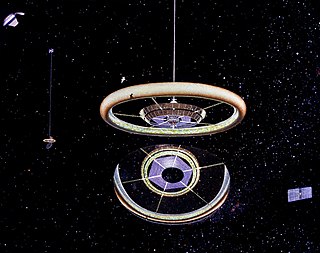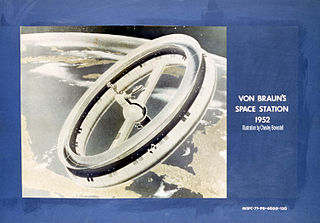
Space colonization is the use of outer space for colonization, such as permanent habitation, exploitation or territorial claims. Extraterrestrial colonization is its broader form, including the use of celestial bodies, other than Earth, for colonization.

A Bernal sphere is a type of space settlement intended as a long-term home for permanent residents, first proposed in 1929 by John Desmond Bernal.

A space settlement is a settlement in outer space, sustaining more extensively habitation facilities in space than a general space station or spacecraft. Possibly including closed ecological systems, its particular purpose is permanent habitation.

The Stanford torus is a proposed NASA design for a space settlement capable of housing 10,000 to 140,000 permanent residents.

The Millennial Project: Colonizing the Galaxy in Eight Easy Steps by Marshall T. Savage is a book in the field of exploratory engineering that gives a series of concrete stages the author believes will lead to interstellar colonization. Many specific scientific and engineering details are presented, as are numerous issues involved in space colonization.

Gerard Kitchen O'Neill was an American physicist and space activist. As a faculty member of Princeton University, he invented a device called the particle storage ring for high-energy physics experiments. Later, he invented a magnetic launcher called the mass driver. In the 1970s, he developed a plan to build human settlements in outer space, including a space habitat design known as the O'Neill cylinder. He founded the Space Studies Institute, an organization devoted to funding research into space manufacturing and colonization.

Colonization of the Moon is a process or concept employed by some proposals for robotic or human exploitation and settlement endeavours on the Moon. Settling of the Moon is, therefore, a more specific concept of lunar habitation, for which the broader concept of colonization is often used as a synonym, a use that is contested in the light of colonialism and its claiming of space.

A megastructure is a very large artificial object, although the limits of precisely how large vary considerably. Some apply the term to any especially large or tall building. Some sources define a megastructure as an enormous self-supporting artificial construct. The products of megascale engineering or astroengineering are megastructures.
Ben J. Bussey is an American planetary scientist.

Space manufacturing or In-space manufacturing is the fabrication, assembly or integration of tangible goods beyond Earth's atmosphere, involving the transformation of raw or recycled materials into components, products, or infrastructure in space, where the manufacturing process is executed either by humans or automated systems by taking advantage of the unique characteristics of space. Synonyms of Space/In-space manufacturing are In-orbit manufacturing, Off-Earth manufacturing, Space-based manufacturing, Orbital manufacturing, In-situ manufacturing, In-space fabrication, In-space production, etc.
The L5 Society was founded in 1975 by Carolyn Meinel and Keith Henson to promote the space colony ideas of Gerard K. O'Neill.

The concepts of space stations and space habitats feature in science fiction. The difference between the two is that habitats are larger and more complex structures intended as permanent homes for substantial populations, but the line between the two is fuzzy with significant overlap and the term space station is sometimes used for both concepts. The first such artificial satellite in fiction was Edward Everett Hale's "The Brick Moon" in 1869, a sphere of bricks 61 meters across accidentally launched into orbit around the Earth with people still onboard.

Lagrange point colonization is a proposed form of space colonization of the five equilibrium points in the orbit of a planet or its primary moon, called Lagrange points.

A rotating wheel space station, also known as a von Braun wheel, is a concept for a hypothetical wheel-shaped space station. Originally proposed by Konstantin Tsiolkovsky in 1903, the idea was expanded by Herman Potočnik in 1929.

2081: A Hopeful View of the Human Future is a 1981 book by Princeton physicist Gerard K. O'Neill. The book is an attempt to predict the social and technological state of humanity 100 years in the future. O'Neill's positive attitude towards both technology and human potential distinguished this book from gloomy predictions of a Malthusian catastrophe by contemporary scientists. Paul R. Ehrlich wrote in 1968 in The Population Bomb, "in the 1970s and 1980s hundreds of millions of people will starve to death". The Club of Rome's 1972 Limits to Growth predicted a catastrophic end to the Industrial Revolution within 100 years from resource exhaustion and pollution.
Universal Century technology refers to technology created in the fictional Universal Century timeline of the Gundam anime media mix. Although they are only fictional technologies, they form the base of the Real Robot genre that the anime originates from. These technologies and their theory are now influential to factual academic research. They have also influenced creations in other Animation series.

Space architecture is the theory and practice of designing and building inhabited environments in outer space. This mission statement for space architecture was developed at the World Space Congress in Houston in 2002 by members of the Technical Aerospace Architecture Subcommittee of the American Institute of Aeronautics and Astronautics (AIAA). The architectural approach to spacecraft design addresses the total built environment. It is mainly based on the field of engineering, but also involves diverse disciplines such as physiology, psychology, and sociology.
A Bishop Ring is a type of hypothetical rotating space habitat originally proposed in 1997 by Forrest Bishop of the Institute of Atomic-Scale Engineering. The concept is a smaller scale version of the Banks Orbital, which itself is a smaller version of the Niven ring. Like other space habitat designs, the Bishop Ring would spin to produce artificial gravity by way of centrifugal force. The design differs from the classical designs produced in the 1970s by Gerard K. O'Neill and NASA in that it would use carbon nanotubes instead of steel, allowing the habitat to be built much larger. In the original proposal, the habitat would be approximately 1,000 km (620 mi) in radius and 500 km (310 mi) in width, containing 3 million square kilometers of living space, comparable to the area of Argentina or India.

An O'Neill cylinder is a space settlement concept proposed by American physicist Gerard K. O'Neill in his 1976 book The High Frontier: Human Colonies in Space. O'Neill proposed the colonization of space for the 21st century, using materials extracted from the Moon and later from asteroids.



























